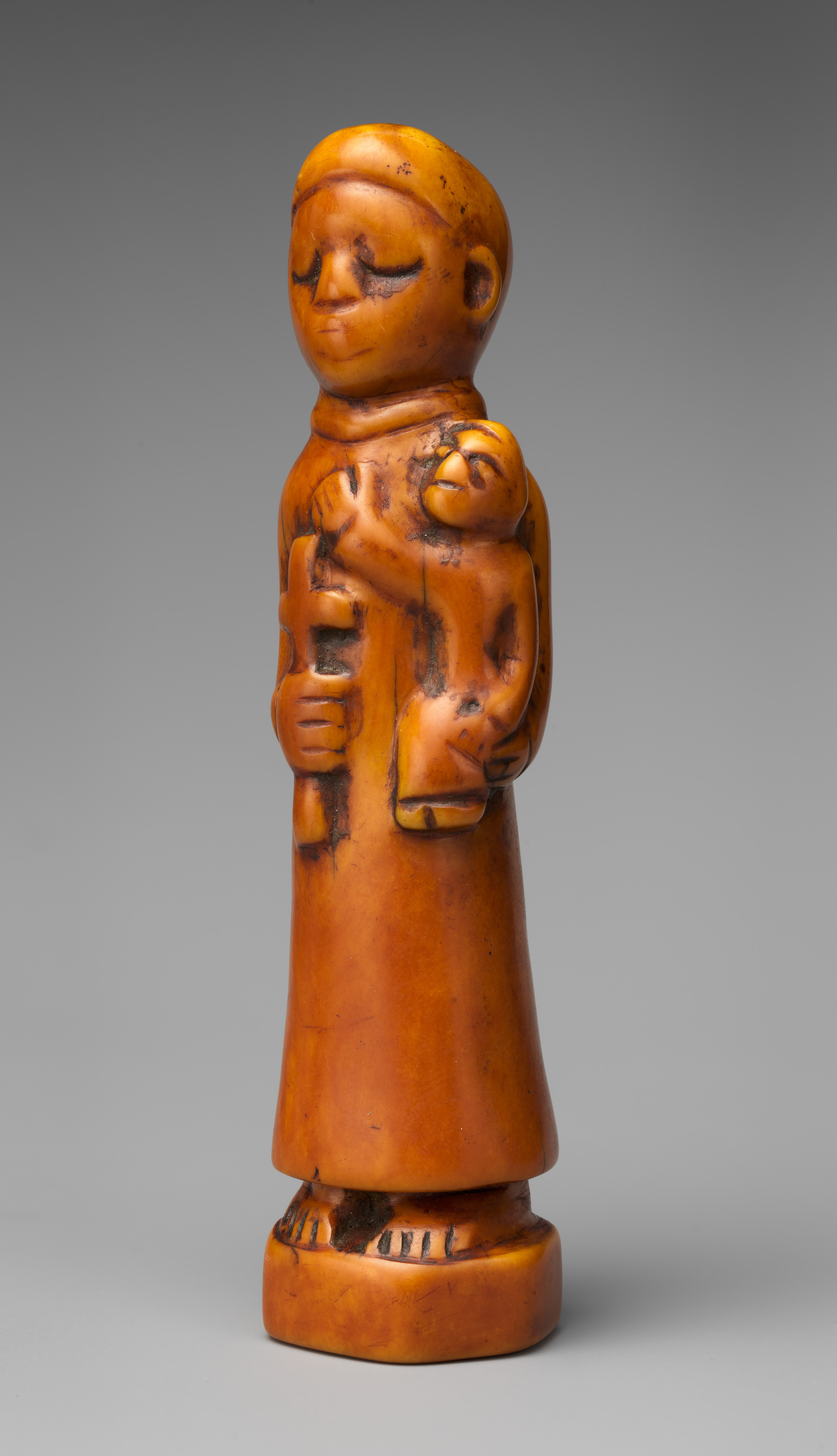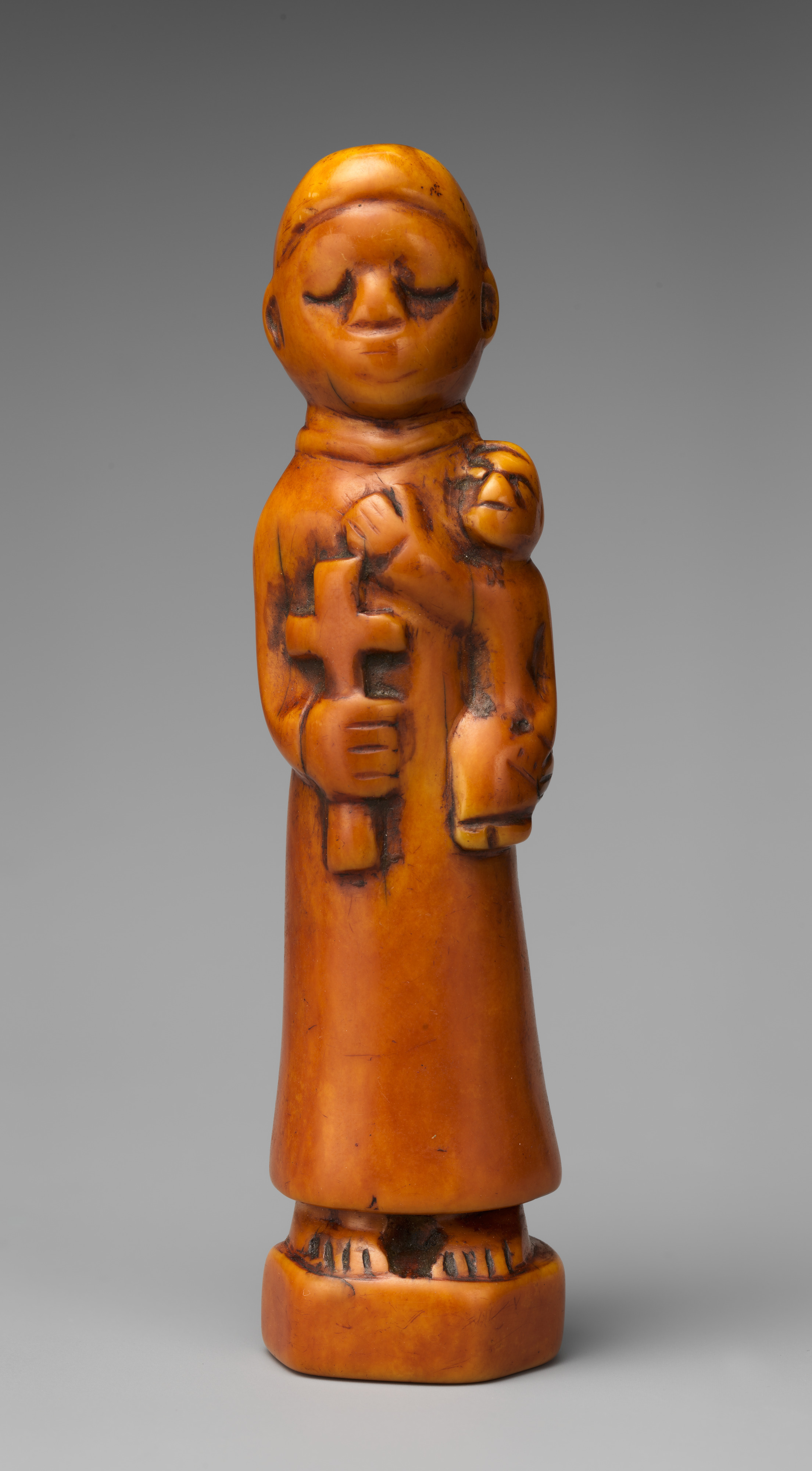Figure: Saint Anthony (Toni Malau)
Not on view
This small ivory pendant of St. Anthony of Padua holding the infant Christ plays with proportion to emphasize aspects of its diminutive composition. The saint’s head is oversized in relation to his body, providing an expansive surface for his simply incised facial features. The eyes are inverted crescent moons, the nose a trapezoid, and the mouth a barely visible line scratched above the curved chin. Altogether, his impression is meditative, in contrast to the alert, open-eyed gaze of the Christ child, who stretches out his arm to embrace the elder saint, the child’s hand just grazing the top of the solid crucifix. Though only an infant, Christ is half the size of the saint, emphasizing his importance in Christian theology. His physical proximity to the cross alludes to his future sacrifice. Each figure has bare feet, and wears a long-sleeved tubular robe that slightly flares. The toes and fingers are articulated with simple parallel lines. St. Anthony stands feet shoulder with apart, toes slightly pointed inwards, on a thick hexagonal base with soft angles at each corner.
The diminutive size of this figure and the loop carved between its shoulders indicate that it is a pendant. Originally cream colored, the figure is now covered with a rich honey-toned patina, which is redder on the reverse, suggesting that the pendant came into contact with the skin through active wear, and that it was possibly anointed with oils or spiritually significant substances, like red tukula. The powdered bark of the redwood or camwood trees, tukula could be applied to the body or textiles for cosmetic or religious purposes. Whereas the back of the head is rounded, the front of the face is flat, suggesting a gradual lowering of the carved facial features through repeated rubbing. A dark red-black resin has also accumulated in the crevices of the carving, and around the saint’s feet. A hole at the bottom of the base may have been used to support the ivory during carving, or alternately, could have been used to affix the pendant to a staff. Examinations performed in 2013 by Conservator Ellen Howe, Conservation Fellow Ainslie Harrison, and Conservation Scientist Adriana Rizzo suggest that this work was most likely carved from the incisor of a hippopotamus, a species endemic to the Congo River region.
Catholic since the late fifteenth century, the Kongo Kingdom fostered devotion to many saints. St. Anthony was among the foremost, and was called Toni Malau (“Anthony of Good Fortune”) for his purported powers of healing and good luck. The figure’s attributes confirm his identity: the cross held in his proper right hand, the Christ child balanced on the low curve of his left elbow, and his simple habit. Although a researcher has suggested that the iconography of this figure is atypical, it is in fact consistent with later depictions of the saint (Object File, The Metropolitan Museum of Art). While earlier portrayals made by artists in Kongo and across the world show St. Anthony holding the Christ child on a book (as evident in the brass pendant, 1999.295.1), this feature was diminished or completely absent in later depictions.
The popularity of Saint Anthony in Kongo was part of an early modern phenomenon in which the saint was equally popular in Europe, South America, and Africa. Born in Lisbon, Portugal in 1195, the Franciscan brother Anthony was canonized just one year after his 1231 death in Padua, Italy. Claimed as a patron saint by both Portugal and Italy, religious missionaries from both regions spread his cult globally. Soon after their 1645 arrival in Kongo, Italian Capuchin fathers began to spread the cult of St. Anthony. While most early images of the saint were brought from Europe, some came to Africa via other sources. Most missionaries traveled indirectly to Africa via Brazil, where they sometimes purchased religious sculptures from Portuguese colonial workshops. In the Kongo kingdom, locally made figures of Saint Anthony based on European prototypes became common around the eighteenth century. The practice most likely related to the saint’s popularity in the kingdom, and was possibly tied to the short-lived Antonian movement, during which the Kongo noble woman Beatriz Kimpa Vita gained a significant political following after declaring herself the reincarnation of St. Anthony. To the chagrin of European missionaries, the Antoniens adopted the metal, ivory, and wooden images of St. Anthony, wearing the sculpture of the saint they called Toni Malau as a sign of their allegiance and as a protective amulet. The Little Anthonies occupied the capital and traveled throughout the Kongo kingdom wearing their medallions, spreading the message of Dona Beatriz, who believed that Africanizing the church would strengthen the Kongo state, which was in disarray after a series of civil conflicts and the rising effects of the Transatlantic slave trade.
While the Antonien movement was successfully put down in 1706, St. Anthony remained popular long after. Considered the “Saint of Good Fortune” or the “Saint of Prosperity,” Toni Malau figures continued to be used prominently in Kongo as forms of protection from illness, the troubles of childbirth, or other problems.
Kristen Windmuller-Luna, 2016
Sylvan C. Coleman and Pam Coleman Memorial Fund Fellow in the Department of the Arts of Africa, Oceania, and the Americas
Exhibition history:
“African, Oceanic, and Ancient American Art: Recent Acquisitions” Michael C. Rockefeller Special Exhibition Gallery, The Metropolitan Museum of Art, New York, NY: May 22-Oct. 28, 2001
Further reading:
Fromont, Cécile. The Art of Conversion: Christian Visual Culture in the Kingdom of Kongo. Chapel Hill, NC: University of North Carolina Press, 2014.
Pereira, Mario, and Kristen Windmuller-Luna. "Kongo Christian Art: Cross-Cultural Interaction in the Atlantic World." Kongo: Power and Majesty Exhibition Blog, The Metropolitan Museum of Art (blog), October 30, 2015.
Thornton, John K. The Kongolese Saint Anthony: Dona Beatriz Kimpa Vita and the Antonian Movement, 1684-1706. Cambridge, U.K.: Cambridge University Press, 1998.
Due to rights restrictions, this image cannot be enlarged, viewed at full screen, or downloaded.
This artwork is meant to be viewed from right to left. Scroll left to view more.





